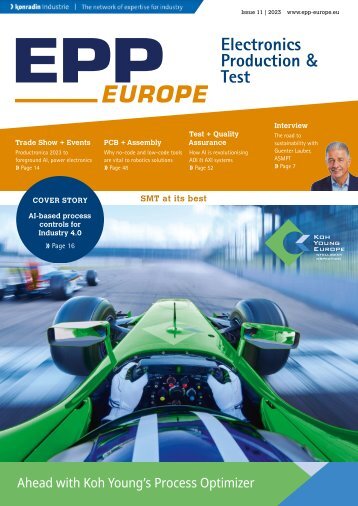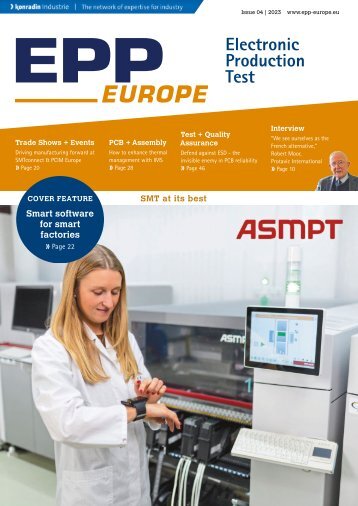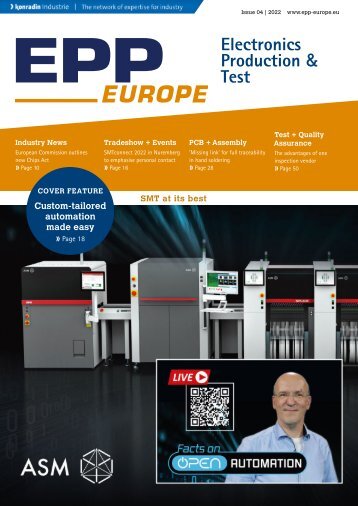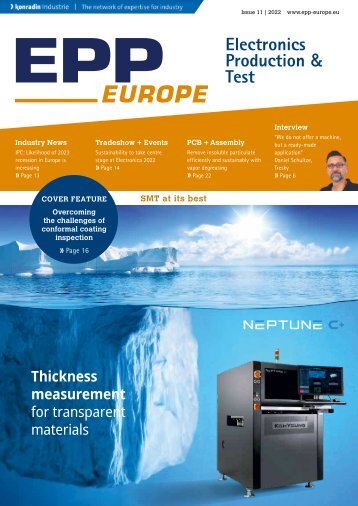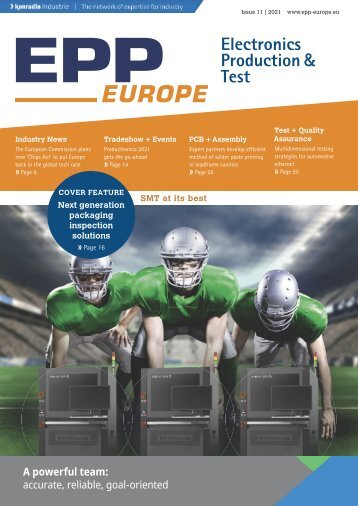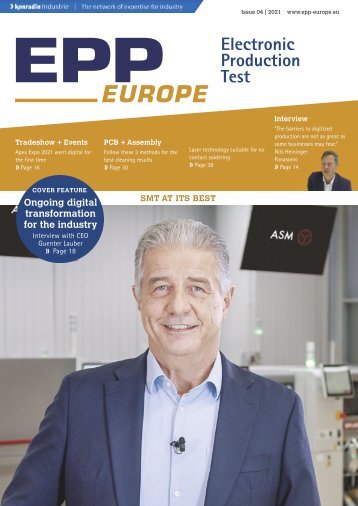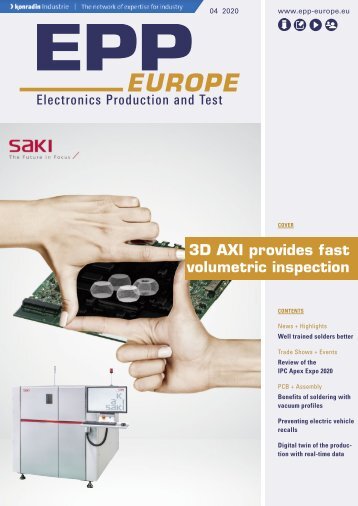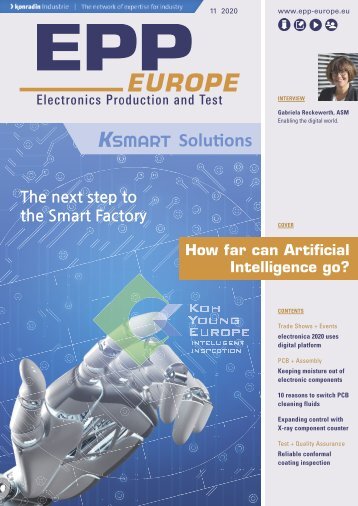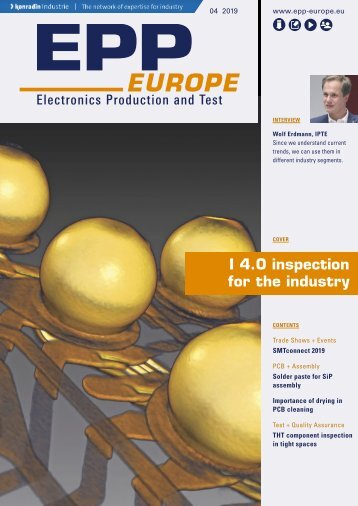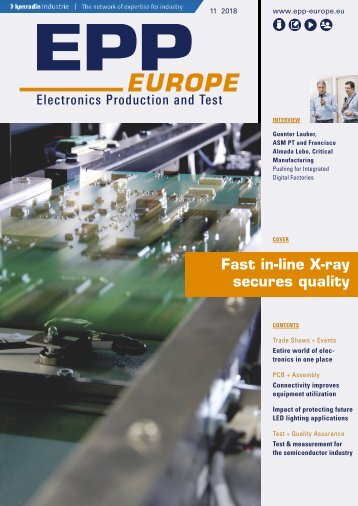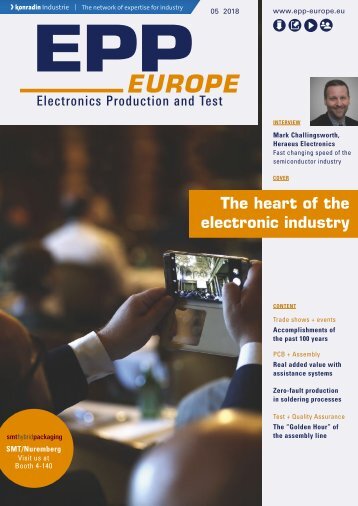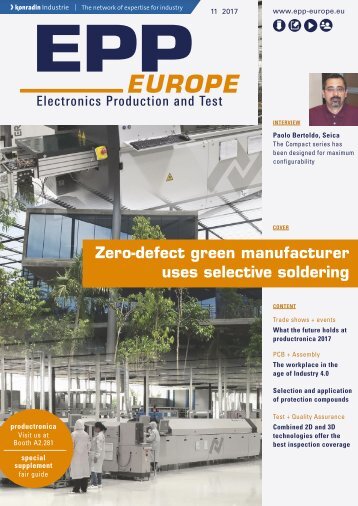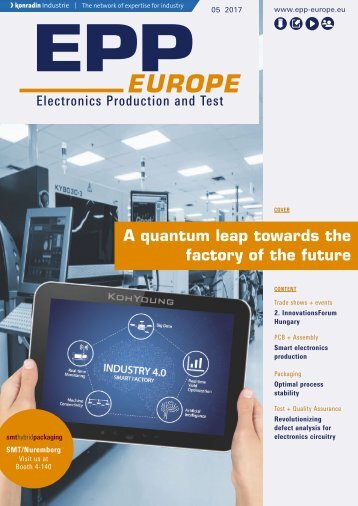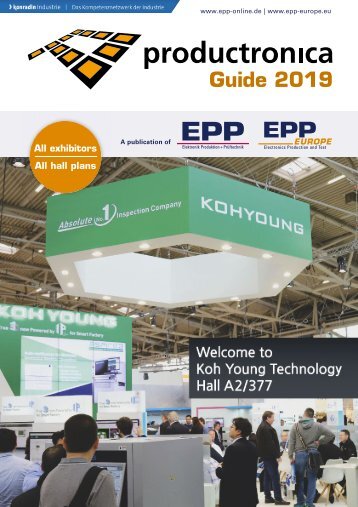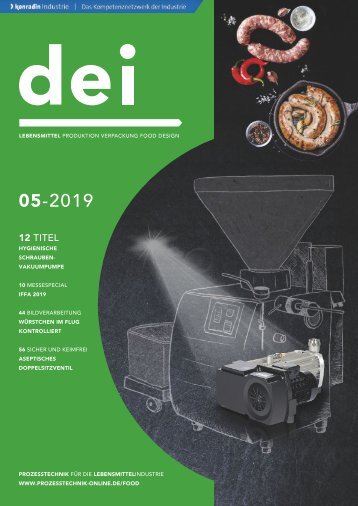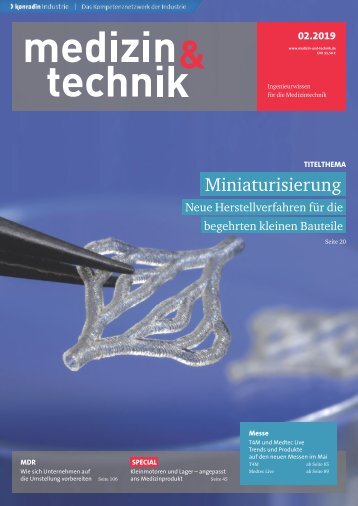EPP Europe P2.2022
- Text
- Measurement
- Assembly
- Semiconductor
- Soldering
- Solutions
- Manufacturing
- Components
- Electronic
- Inspection
- Electronics
PCB & ASSEMBLY »
PCB & ASSEMBLY » Product Updates New ventilation management system enables energy savings of up to 50% MK Versuchsanlagen introduces further developed wet workbench Source: MK Versuchsanlagen Frontal view of two MK wet workbenches with different internals and connections German special equipment manufacturer, MK Versuchsanlagen und Laborbedarf has announced it has further developed its wet workbench. The company says the applications of the wet workbench, which it newly introduced two years ago, are extremely diverse. The metal-free system is particularly suitable for use in the semiconductor industry: substrate cleaning; and pre- and post-treatment of silicon wafers, glass substrates and all other start and end products in these fields. The manufacturer says it developers have paid particular attention to the intelligent ventilation management system, which enables energy savings of up to 50 percent. Continuous monitoring of the wet workbench ensures that the volume flow of the air introduced is automatically adjusted. The control variables are controlled via dedicated PLC modules. Possible control loops such as activity or particle monitoring are individually defined and implemented, depending on the application. Energy improvements for existing laboratories are also possible - in many cases in the form of a so called ‘retrofit’. mk-versuchsanlagen.de Pressure-temperature sensor technology ViscoTec debuts miniature flush pressure sensor ViscoTec has announced the launch of the world’s smallest flush pressure sensor with a chemical – largely inert – pressure membrane made of FFKM. The company says the miniature sensor known as flowplus-SPT M6 is also currently the only sensor that achieves both pressure and temperature measurement with an M6 thread as process connection and a sensor body that is only 15.3 mm short. The new sensor is able to measure the pressures of the material to be dispensed up to 40 bar at a temperature range from 5 to 50°C. It fits into the material outlet of the manufacturer’s dispensing systems, but can also be installed in other applications, where its small design reduces possible material losses due to dead space-optimized components. Thanks to its intuitive mechanics and short cable length, integration into the company’s own dispensers is quick and easy, so that the sensor is immediately ready for process data acquisition. According to the company, the integrated electronics convert the recorded pressures and temperatures into an analog voltage signal, which enables uncomplicated and fast integration into control systems such as a PLC. The low measurement tolerance of only 2 % and the resulting high measurement accuracy ensure precise and, at the same time, simple processing of the recorded measurement data. In addition, possible cable breaks can be detected via a drop in the pressure-dependent voltage signal below 0.1 V using the master-level control system. “Thanks to its dust- and splash-proof design (protection class IP54), the new sensor operates confidently and reliably in industrial environments even without the attachment of further housing components, the company said. The sensor body is made of stainless steel and is therefore largely resistant to the effects of every conceivable material. Furthermore, the measuring membrane made of FFKM is significantly more resistant than conventional membranes, which is reflected in noticeably reduced maintenance and spare parts costs. By means of a chemical resistant, drag chain suitable sensor connection cable, the smooth coupling with ViscoTec controllers via a 4-pole M8 standard connection is possible.” www.viscotec.de The company says the miniature sensor known as flowplus-SPT M6 is also currently the only sensor that achieves both pressure and temperature measurement with an M6 thread as process connection and a sensor body that is only 15.3 mm short Source: ViscoTec 34 EPP Europe » 11 | 2022
Dual-curing adhesive for medical device applications Panacol develops first UV moisture-curing medical adhesive the adhesive to cure while still in the dispensing needle. This offers the user a wide process window. In addition, there are no blooming of frosting effects on the plastics, which can occur when using cyanoacrylates. Source: Panacol The company says the UV acrylate is ideally suited for fixing batteries on glucose sensors (corner bonding) Industrial adhesives provider Panacol has developed a new adhesive system certified for use in the medical industry known as Vitralit UD 8050 MV F. The company says that in addition to its primary curing – UV crosslinking, the new adhesive also offers secondary moisture post-curing. This means that components in medical devices can be cured in a process-safe manner and without thermal influence, even if shadow zones are present in component cavities. Two challenges commonly arise in medical applications when bonding plastics or assembling PCBs and FPCBs. Not every plastic is transparent, which makes it difficult to cure UV adhesives in a processsafe manner. In most cases, thermal post-curing is relied upon. However, thermal curing often becomes the second challenge. Not all electronic components and plastics can be subjected to thermal stress. In these cases, curing with heat is not a viable option. Dual-curing The primary curing of the new adhesive can be carried out in seconds with UV or LED UV light. LED curing units with a wavelength of 405 nm, such as the LED Spot 100 IC from Hönle, are best suited here. Secondary curing of the adhesive in the shadow areas that are not reached by the UV/visible light takes place through a moisture curing process. Surface and atmospheric moisture react with the adhesive to initiate a curing process. Unlike moisture curing cyanoacrylates, the new adhesive can be processed reliably because its primary curing is based on UV crosslinking. Moisture in the air does not cause Adhesion to different substrates Vitralit 8050 MV F is certified according to ISO 10993–5/-10/-23 biocompatibility testing. Since the dual-curing adhesive exhibits high adhesion to many different substrates, it is the optimal solution for a wide variety of bonding applications. The UV acrylate is ideally suited for fixing batteries on glucose sensors (corner bonding). It can also be used as a glob top for protecting SMD components. The adhesive will cure reliably and stress-free, even in the shadow areas under the bonding wires. When used for structural bonding, it can be applied between transparent and non-transparent substrates. Bonding is accomplished in seconds with UV/visible light. Shadowed areas will subsequently post-cure with moisture. Due to its high ionic purity, the adhesive can be processed on metallized surfaces without hesitation. For optical quality control of the bond, the material is additionally equipped with fluorescent markers that can be excited with short-wave light. www.panacol.de DISCOVER 1 STOP SMART SOLUTION YSP10 Printer YSi-SP SPI YRM20 Mounter YRM20 Mounter YRM20 Mounter YRi-V 3D AOI info-ymeim@yamaha-motor.de +49 2131 20 13 520 smt.yamaha-motor-im.de EPP Europe » 11 | 2022 35
- Page 1 and 2: Issue 11 | 2022 www.epp-europe.eu E
- Page 3 and 4: » EDITORIAL » EDITORIAL Dear read
- Page 5 and 6: Vapor degreasing: almost all semico
- Page 7 and 8: duce machines in high quantities wi
- Page 9 and 10: NEWS & HIGHLIGHTS « 3. Digital sup
- Page 11 and 12: Boost for U.S. semiconductor indust
- Page 13 and 14: NEWS & HIGHLIGHTS « QUALITY PIEKTR
- Page 15 and 16: TRADE SHOWS & EVENTS « ified the g
- Page 17 and 18: AT A GLANCE In this article, Koh Yo
- Page 19 and 20: The LIFT measurement principle. The
- Page 21 and 22: MK Versuchsanlagen PCB maker acquir
- Page 23 and 24: Bild: Microcare Particulate contami
- Page 25 and 26: Rework technologies PDR launches in
- Page 27 and 28: Versatile format The biggest differ
- Page 29 and 30: Product Updates « PCB & ASSEMBLY I
- Page 31 and 32: PCB & ASSEMBLY « Source: ED&A Sour
- Page 33: Adhesives manufacturer strengthens
- Page 37 and 38: Selective soldering systems Sasinno
- Page 39 and 40: New online offering for 4K digital
- Page 41 and 42: Source: Göpel electronic AXI text
- Page 43 and 44: Zusammenfassung Röntgensysteme mü
- Page 45 and 46: RF performance characterization Tes
- Page 47 and 48: G3VM-21MT reference design board te
- Page 49 and 50: The range of T-circuit MOSFET relay
- Page 51 and 52: MEETINGS & COURSES Jan. 21-26 CONFE
Inappropriate
Loading...
Mail this publication
Loading...
Embed
Loading...

